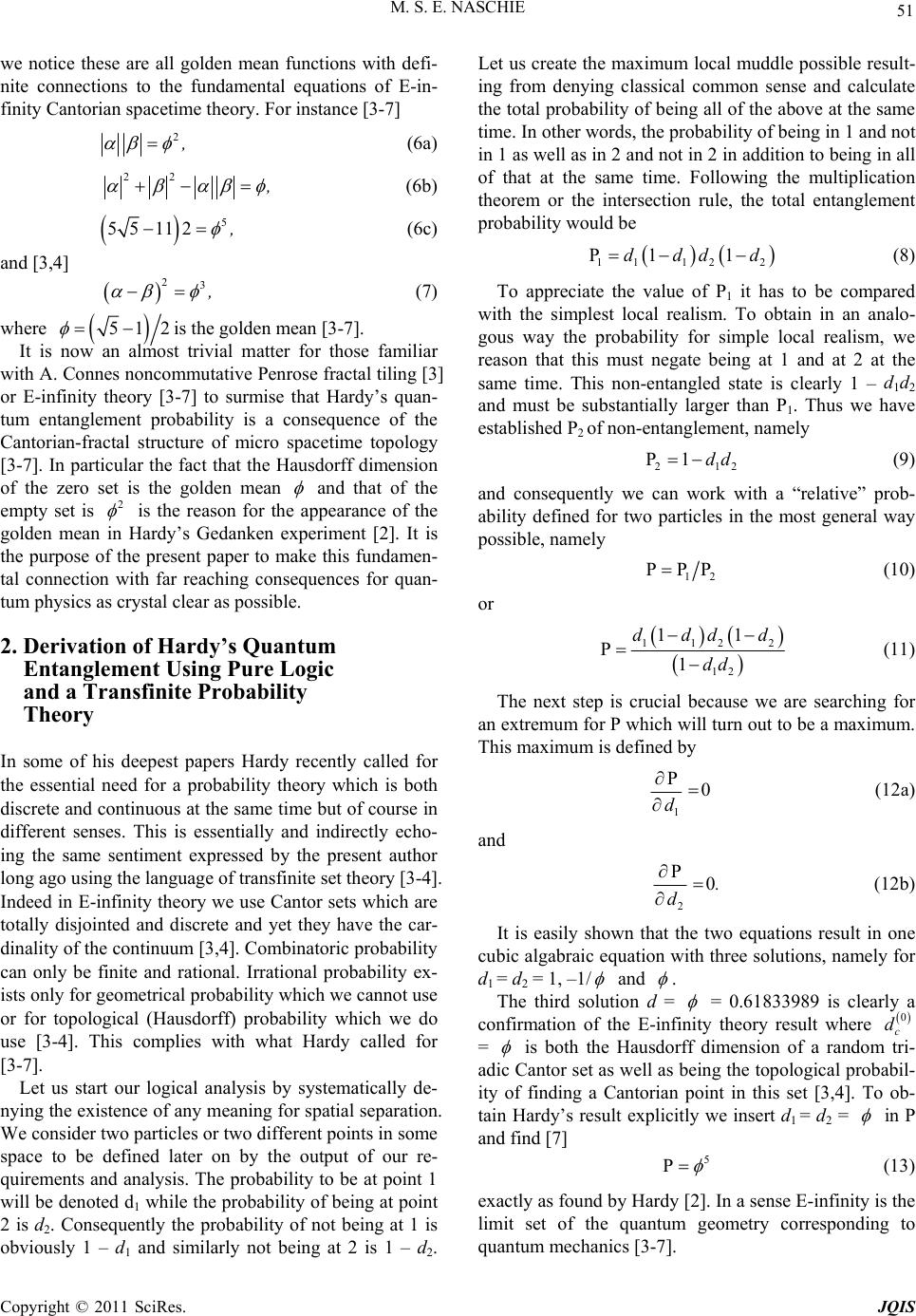
51
M. S. E. NASCHIE
we notice these are all golden mean functions with defi-
nite connections to the fundamental equations of E-in-
finity Cantorian spacetime theo ry. For instance [3-7]
2,
(6a)
22 ,
(6b)
5
55 112,
(6c)
and [3,4]
23,
(7)
where
512
is the golden mean [3-7 ].
It is now an almost trivial matter for those familiar
with A. Connes noncommutative Penrose fractal tilin g [3]
or E-infinity theory [3-7] to surmise that Hardy’s quan-
tum entanglement probability is a consequence of the
Cantorian-fractal structure of micro spacetime topology
[3-7]. In particular the fact that the Hausdorff dimension
of the zero set is the golden mean
and that of the
empty set is 2
is the reason for the appearance of the
golden mean in Hardy’s Gedanken experiment [2]. It is
the purpose of the present paper to make this fundamen-
tal connection with far reaching consequences for quan-
tum physics as crystal clear as possible.
2. Derivation of Hardy’s Quantum
Entanglement Using Pure Logic
and a Transfinite Probability
Theory
In some of his deepest papers Hardy recently called for
the essential need for a probability theory which is both
discrete and continuous at the same time but of course in
different senses. This is essentially and indirectly echo-
ing the same sentiment expressed by the present author
long ago using the language of transfinite set theory [3-4].
Indeed in E-infinity theory we use Cantor sets which are
totally disjointed and discrete and yet they have the car-
dinality of the continuum [3,4]. Combinato ric probability
can only be finite and rational. Irrational probability ex-
ists only for geometrical probability wh ich we cannot use
or for topological (Hausdorff) probability which we do
use [3-4]. This complies with what Hardy called for
[3-7].
Let us start our logical analysis by systematically de-
nying the existence of any meaning for spatial separation.
We consider two particles or two different points in some
space to be defined later on by the output of our re-
quirements and analysis. The probability to be at point 1
will be denoted d1 while the probability of being at po int
2 is d2. Consequently the probability of not being at 1 is
obviously 1 – d1 and similarly not being at 2 is 1 – d2.
Let us create the maximum local muddle possible result-
ing from denying classical common sense and calculate
the total probability o f being all of the above at the same
time. In other words, the probability of being in 1 and no t
in 1 as well as in 2 and not in 2 in addition to be ing in all
of that at the same time. Following the multiplication
theorem or the intersection rule, the total entanglement
probability would be
11 122
P1 1dddd (8)
To appreciate the value of P1 it has to be compared
with the simplest local realism. To obtain in an analo-
gous way the probability for simple local realism, we
reason that this must negate being at 1 and at 2 at the
same time. This non-entangled state is clearly 1 – d1d2
and must be substantially larger than P1. Thus we have
established P2 of non-entanglement, namely
21
P1dd
2
(9)
and consequently we can work with a “relative” prob-
ability defined for two particles in the most general way
possibl e, na mely
12
PPP
(10)
or
112 2
12
11
P1
dddd
dd
(11)
The next step is crucial because we are searching for
an extremum for P which will turn out to be a maximum.
This maximum is defined by
1
P0
d
(12a)
and
2
P0.
d
(12b)
It is easily shown that the two equations result in one
cubic algabraic equation with three solution s, namely for
d1 = d2 = 1, –1/
and
.
The third solution d =
= 0.61833989 is clearly a
confirmation of the E-infinity theory result where
=
0
c
d
is both the Hausdorff dimension of a random tri-
adic Cantor set as well as being the topological probabil-
ity of finding a Cantorian point in this set [3,4]. To ob-
tain Hardy’s result explicitly we insert d1 = d2 =
in P
and find [7]
5
P
(13)
exactly as found by Hardy [2]. In a sense E-in finity is the
limit set of the quantum geometry corresponding to
quantum mechanics [3-7].
Copyright © 2011 SciRes. JQIS